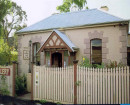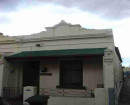Back to search results
STEIGLITZ
CLOW STREET AND STAWELL STREET AND MOLESWORTH STREET STEIGLITZ, GOLDEN PLAINS SHIRE
STEIGLITZ
CLOW STREET AND STAWELL STREET AND MOLESWORTH STREET STEIGLITZ, GOLDEN PLAINS SHIRE
All information on this page is maintained by Heritage Victoria.
Click below for their website and contact details.
Victorian Heritage Inventory
-
Add to tour
You must log in to do that.
-
Share
-
Shortlist place
You must log in to do that.
- Download report
On this page:
Statement of Significance
What is significant?
How is it significant?
Why is it significant?
Show more
Show less
-
-
STEIGLITZ - History
Steiglitz was mainly a quartz reefing field. The division's first gold discoveries were along the Moorabool River, near Morrison's Station; at Dollys Creek; and in the vicinity of Steiglitz. Made as early 1851, these discoveries, and others, did not lead to anything as the gold was not recovered in payable quantities. Gold rushes to the area did not take place until late 1855 after Hooley and Davis discovered a rich reef at Steiglitz. Gold from this reef, when assayed at Geelong, went 72 ounces to the ton. The assay results saw Steiglitz rushed and there were soon 200 miners on the field. During the next four years, the bulk of Steiglitz's reefs (over forty) were discovered While the alluvial miners’ efforts were concentrated in the northern part of the division, the miners at Steiglitz quickly established a vigorous quartz mining industry. The first crushing machinery appears to have been erected on Davis Reef, by a Mr Kitz and by the end of 1856 there were seven crushing machines on the Steiglitz field, four of which were steam-driven. Some of the early mills like Love's and Otway's crushing works had both stamping batteries and Chilean wheels. The high cost of crushing at these works, often forced mines to be abandoned. Despite improvements in plant, miners by 1859 still had to obtain stone going more than 1 oz. to the ton before it could be crushed for a profit. Despite the odd patches of richness, sometimes up to 33 ounces per ton, the miners were working complex reef geology, and their smallness of their claims made it generally impossible to achieve a steady and payable gold production. By 1859 many of the small claims were being amalgamated into large leases worked by public companies (known as joint-stock companies). These companies erected large and very expensive pumping, winding and crushing machinery. The local community eagerly waited the time when the new mines - Steiglitz, Perseverance, Gibraltar, Albion, Malakoff, Sailors Reef, and Redan - would commence producing gold. None of the companies, however, were successful, with the Albion Company on Portuguese Reef being the most vigorous of the early companies. It was estimated that is cost £6000 to sink a shaft to the water level - average depth of 140ft - on the Steiglitz field. The registrar calculated that about half a million pounds had been expended on the field - some shafts having reached 350 ft - an no large (permanent) ore body had been found. When the 1859 company boom collapsed, many of the Steiglitz companies prevailed by crushing mullock and quartz discarded by previous ventures. A second boom burst on Steiglitz in 1865, with twenty new or re-formed companies appearing within the space of three months. The boom was based a reliance on new technology and improved (systematic) methods of underground mining. By September 1865, some £16,000 had been invested on new machinery, dams, and underground works. Within the year at least ten of the new companies had floundered, e.g., Follow-the-Leader Co. crushed 1,780 tons for a measly 178 ounces of gold. For most of the 1870s mining on the Steiglitz field was extremely dull. By 1879 only a hundred or so miners were at work on the field. About the only notable thing to have occurred during this time, was the construction of a pyrites works by the Albion Company. There was a brief flurry of activity in the early 1880s when three new co-operative companies were formed Mining at Steiglitz in the 1890s was revived by the increased production from the North Birmingham and also the New or United Albion. With the rise in gold yields, capital once more flowed into the field and new companies formed. One of the new companies, the New Mariner, which was working ground on the southern end of the field, was to be extremely successful (in terms of Steiglitz) and paid out £56,000 in dividends. The other main dividend payer of the early 1890s boom was the United On this day, a bushfire swept down on Steiglitz and consumed many of the town's buildings along with the top gear of the major mines. For the mining community it could not have come at a worse time: its two leading mines were struggling, they had exhausted all known ore reserves. By the end of 1896 both the New Mariners and United Albion were being worked by tributers. The formation of the Ballarat Steiglitz G. M. Company in 1897 turned out to be the last effort in haling the decline of the field. Albion with £15,000 in dividends. The mining boom peaked in 1984 with some forty reefs being worked and the town's population at 2,000. While large scale underground operations collapsed during the 1890s, the Steiglitz field received a boost through the introduction of the cyanide process. By 1897 there were at least two companies using the new technology: the Hanover Cyanide and Hans Irvines Cyanide works. By means of these plants lost gold (naked to the eye) was retrieved from the waste (tailings) left behind by the crushing mills. The new technology could not save the field, and by 1904 the town's population had dropped to 150. The Great Depression, which saw the price of gold rise from £4 to £8 generated considerable mining activity in Victoria. There was renewed prospecting and cyaniding of tailings on the Steiglitz field during this time, but with no notable results. There was also some tunnelling into the sides of Sutherland Creek. The Dreadnought mine was the last to operate in this brief period of revived mining. It closed down in 1941.STEIGLITZ - Interpretation of Site
H7722-0015 takes in all of the Steiglitz Historic Area. This landscape contains a number of sites associated with the town and its associated quartz mining. The two sites inspected were picked up as FMQF locations: HISTPOINT-1002087 – cyanide vats; FMQF 30 – Tailings; HISTPOINT-100 1589 – Brick chimney
Heritage Inventory Description
STEIGLITZ - Heritage Inventory Description
Remains of early 1850's gold mining town.
Heritage Inventory Significance: State
SiteCard data copied on 04/07/2024: The two sites picked up as FMQF locations inspected were: Cyanide works contain two G.I. vats located on an upper platform and a single G.I vat below with a small zinc box attached. Most likely this site due to its condition dates to the second phase of cyaniding carried out at Steiglitz. Hut site – this contains a standing brick chimney associated with a benched hut platform. Nearby, to the south is the remains of a cellar (maybe cool room) and a brick lined well.
-
-
-
-
-
FORMER STEIGLITZ COURT HOUSE
 Victorian Heritage Register H1487
Victorian Heritage Register H1487 -
New Chum School (former)
 Golden Plains Shire
Golden Plains Shire -
Minogues Store (former)
 Golden Plains Shire
Golden Plains Shire
-
-









